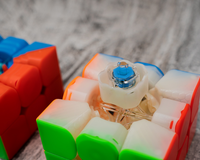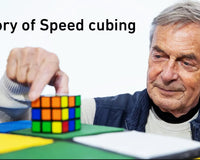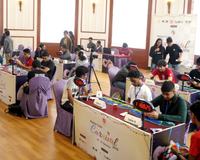Introduction
Solving big cubes like the 6x6 and 7x7 may seem overwhelming, but if you already know how to solve a 3x3, you're halfway there! These cubes follow a similar reduction method: solve centers, pair edges, and then finish using standard 3x3 techniques. Let's break it down step by step.
Understanding the Differences
The main difference between 6x6 and 7x7 cubes is that the 6x6 lacks fixed centerpieces, meaning the centers must be aligned properly as per the colour scheme of the puzzle. The 7x7, however, has a fixed centerpiece that helps with alignment. Additionally, both cubes suffer from parity errors.
Step 1: Solve the Centers

Centers on both the 6x6 and 7x7 are solved first. Since these cubes have more pieces per center, you need to group them correctly. A useful approach is to solve one center entirely and then align the opposite center before moving on to adjacent ones.
- 6x6: Since there is no fixed centerpiece, you need to remember the proper colour scheme of the puzzle or you can also use the corner pieces as references for proper alignment.
- 7x7: The middle centerpiece acts as a guide, making alignment easier. Work on forming 1x4 bars (for 6x6) or 1x5 bars (for 7x7) and then merging them into completed centers.
Step 2: Pair the Edges

Once the centers are done, the next step is edge pairing. Unlike a 4x4, which has two edge pieces in a pair, a 6x6 has four in a set, and a 7x7 has five in a set.
- Use the slice method: Move edge pairs together, match them, and replace them with unsolved edges.
- The main challenge is edge parity errors, which occur when two edges are swapped incorrectly. These must be fixed before proceeding to the 3x3 stage. Learning multiple algorithms does help in solving quicker but there is just one basic parity algorithm that you need to know to correct the edge parity. This algorithm is the same as the OLL parity algorithm with the only difference being the number of layers turned in the R and L moves.
For 6x6, you may encounter OLL parity (flipped edge) and edge parity (swap of two edges). The 7x7 only has edge parity but no OLL parity.
Step 3: Solve Like a 3x3

After centers and edges are completed, the cube effectively behaves like a giant 3x3! Solve it as you normally would using your preferred method (CFOP, Roux, etc.)
- Watch out for parity errors. These are unique to even-layered cubes (like 6x6).
- The 7x7 does not have OLL parity, making the final steps a bit smoother.

Common Parity Algorithms
Here are two essential parity algorithms you’ll need:
- OLL Parity (6x6 Only): 3Rw, U2, X, 3Rw, U2, 3Rw, U2, 3Rw', U2, 3Lw, U2, 3Rw', U2, 3Rw, U2, 3Rw', U2, 3Rw'
- PLL Parity (6x6 only): 3Uw2, 3Rw2, U2, 3Rw2, R2, U2, 3Rw2, 3Uw2

Final Tips
- Practice center efficiency: The better you get at center construction, the faster your overall solve will be.
- Use intuitive edge pairing: Try to recognize patterns rather than relying on algorithms for every step.
- Memorize parity fixes: This will save you a lot of time during solves. Stay patient! Big cubes take time, but once you get comfortable, solving them feels incredibly fun!
Mastering the 6x6 and 7x7 is all about breaking them down into manageable parts!






























